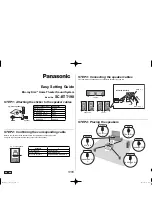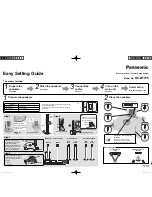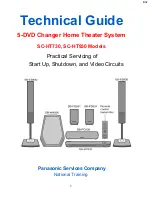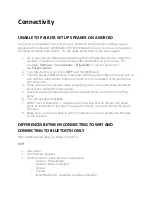
ENGLISH 3
C O N N E C T I N G T H E S P E A K E R S T O T H E S Y S T E M
(Figures E,F & I)
Use two conductor 16 gauge or thicker audiophile grade speaker wires. Measure enough wire to reach from your receiver or amp to each speaker plus an
additional 12" to allow moving the speakers or receiver without having to disconnect the wires. One of the terminals on the rear of the speaker is marked red
(+) and the other black (-). Make certain that you connect the wire from the red (+) terminal of your amplifier to the red (+) terminal on your speaker, and
the wire from the black (-) terminal of the amplifier to the black (-) terminal on your speaker. Most wire has some indication (such as color code, ribbing, or
writing) on one of the two conductors to help maintain consistency. If your speakers sound “thin” with little bass and little to no center image, the chances
are that one of the speaker wires is connected backwards. Double check all connections.
This system features a powered subwoofer (packaged separately) that has a built-in, adjustable low pass filter to separate the bass from the full range signal.
The “subwoofer output” jacks (sometimes labeled “LFE”) on most receivers also contain a fixed low pass filter. If you connect the subwoofer to the receiver’s
subwoofer output jack the two filters will interact and reduce the fidelity of your system. If you follow the hook up and the “receiver set up” instructions
below, you will get all of the bass to the subwoofer and get the highest possible performance from your system. DO NOT USE THE “SUBWOOFER OUTPUT”
(LFE) JACK ON YOUR RECEIVER TO CONNECT THE SUBWOOFER.
B E S T H O O K U P M E T H O D
(Figure G)
"
Connect the left and right front speaker outputs of your receiver or amplifier to the SPEAKER LEVEL INPUTS of the powered subwoofer.
"
Connect the satellite speakers to the SPEAKER LEVEL OUTPUTS of the subwoofer.
"
If it is more convenient, parallel wire the subwoofer and satellites from your receiver. (Figure H)
"
Connect the center channel speaker directly to the center speaker output of your receiver or amplifier.
"
Connect the surround satellites directly to the rear or surround channel outputs of your receiver or amplifier.
R E C E I V E R S E T U P
All surround sound receivers allow you to match the electronics to your speakers. Refer to the owners manual of your receiver or surround processor to learn
how this is done. To get the best performance from the RM6600, use the following settings:
"
Front Speakers - Set to “Large”
"
Center Speaker - Set to “Normal” or “Small”
"
Surround Speakers - Set to “Small”
"
Subwoofer - Set to “Off” or “None.” This setting may not make sense to you as your RM6600 system has a subwoofer,
but really, this is the right setting.
A D J U S T I N G T H E P O W E R E D S U B W O O F E R F O R B E S T P E R F O R M A N C E
(RM6600 System)
"
Start with the VOLUME level at about 1:00. Adjust up or down until you get sufficient bass for your personal taste. Remember that room position can have
a very large affect on perceived bass level.
"
Switch PHASE control to 180° (down position.)
"
Turn the LOW PASS to the middle of the shaded area for best blending between the subwoofer and the satellites. You’ll know the setting is correct when a
high quality recorded male voice sounds full without any chestiness. If vocals sound thin turn this control up—if they sound boomy turn it down.
(See Figures I & J)
S A F E L I M I T S O F O P E R A T I O N
Your Polk loudspeakers are made with the highest quality materials for years of trouble-free performance. However, damage to loudspeakers can occur when
an amplifier, regardless of its wattage, is made to play at higher listening levels than its power can clearly produce (usually beyond the “1 to 2 O’clock” posi-
tion on the volume control).
This results in very high levels of audible distortion, originating in the amplifier, which adds a harsh, gritty sound to the music. Contrary to popular belief, a
speaker is more likely to be damaged by trying to get too much volume from a low-powered amp or receiver than from a high-powered one.
M A I N T A I N I N G T H E A P P E A R A N C E O F R M S E R I E S S P E A K E R S
Your new speaker cabinet is made of a rugged material that can be dusted or cleaned with a moist cloth. Avoid harsh detergents and cleaning fluids; they can
permanently damage your speakers’ finish. Gently vacuum the grilles to remove dust.
T E C H N I C A L A S S I S T A N C E O R S E R V I C E
If, after following the hook-up directions, you experience difficulty, please double check all wire connections. Should you isolate the problem
to the speaker, contact the authorized Polk Audio dealer where you made your purchase or call Polk Audio’s Customer Service Department at
1-800-377-7655 (calls from US or Canada only) from 9am to 5pm, Eastern Time, Monday through Friday. You may also contact us via
email [email protected].




































